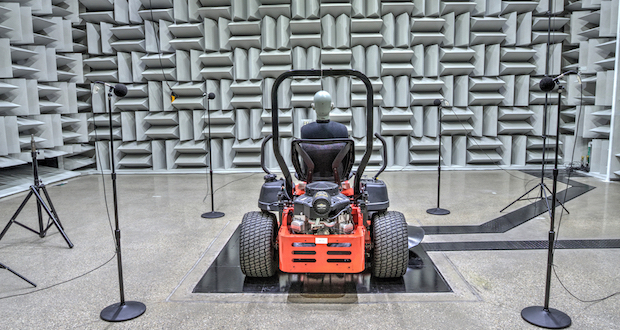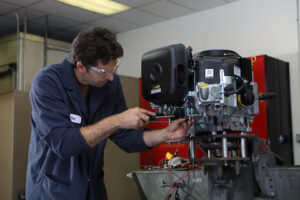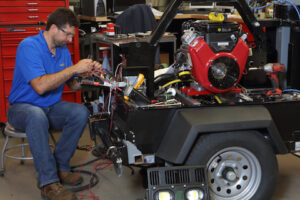Improving Performance Through Engine Integration

By Dennis Steinhardt
Only a select few individuals can buy a suit off the rack and have it fit perfectly without having to make adjustments. But when a suit fits perfectly, you know it, and others will likely take notice as well.
The same is true for engines powering commercial equipment. When engineering new equipment, or repowering older models, choosing an engine within a reasonable horsepower range and bolting it in is not the best plan. Choosing engines that go through a rigorous testing process to ensure the engine perfectly matches the machine and its application will ensure the equipment can withstand the long days and heavy use of today’s contractors while delivering strong ROI.
In some cases, the process of integrating an engine into a new product design can take months – longer if design flaws need to be addressed – but, in the end, proper engine integration helps OEMs deliver better performing and more productive equipment. The engine integration process is most successful and offers the best results when done as a collaborative effort between the engine manufacturer and OEM. Rather than looking at the engine or equipment alone, they should be studied as a cohesive unit to adjust for noise, vibration, risk of overheating, ease of use and power.
Savings can add up quickly for contractors when engine manufacturers take a comprehensive approach to engine integration, equipment optimization, performance, operator comfort and ease of maintenance.
More isn’t always better
If a little is good, more is better. This is true for money, bacon and a lot of other things, but it’s not always the case with horsepower. Matching equipment with the ideal power source is a critical part of the testing process. Everyone knows too little horsepower is bad, but having too much power can negatively impact more than just fuel efficiency. Extra power can cause equipment to vibrate excessively, leading to unnecessary wear and more frequent parts replacements, costing contractors time and money.
 Extra horsepower can also result in less efficient power delivery. In these situations, less power transfers to the machine’s operation. A major consideration during the engine installation testing process is selecting the ideal level of horsepower for the specific piece of equipment.
Extra horsepower can also result in less efficient power delivery. In these situations, less power transfers to the machine’s operation. A major consideration during the engine installation testing process is selecting the ideal level of horsepower for the specific piece of equipment.
When OEMs and engine manufacturers work closely together during the engine integration process, valuable information and data is shared that can result in design adjustments to enhance equipment performance or ergonomics. For example, in a recent application review, an OEM worked with the engine manufacturer to design an engine that could mount at a 35-degree angle, providing for a more optimal and efficient design for the equipment.
Once performance is optimized, additional steps are still required before the equipment is ready for the jobsite.
Cut through the noise
Beyond power, noise and vibration can make or break the performance and lifecycle of equipment. Although both are associated with user comfort, they can also indicate that the engine hasn’t been properly integrated for the application. Vibration can lead to extra maintenance, as well as increased fatigue and decreased performance.
 Thorough testing allows for proactive solutions. To achieve the best results, some engine manufacturers employ specialty engineers with backgrounds, including mechanical, computers, and even acoustics. These engineers adjust how the engine is mounted or make minor design changes to lessen noise and vibration. Slightly adjusting the position of the engine, reinforcing the frame near the mounting location, or adding weights to counter natural engine vibration can go a long way toward producing more efficient and user-friendly equipment.
Thorough testing allows for proactive solutions. To achieve the best results, some engine manufacturers employ specialty engineers with backgrounds, including mechanical, computers, and even acoustics. These engineers adjust how the engine is mounted or make minor design changes to lessen noise and vibration. Slightly adjusting the position of the engine, reinforcing the frame near the mounting location, or adding weights to counter natural engine vibration can go a long way toward producing more efficient and user-friendly equipment.
Equipment operators who were once willing to tolerate unpleasant conditions are no longer willing to accept hearing loss or chronic pain as an occupational hazard. Faced with a shortage of workers and an aging workforce, employers are motivated to provide equipment that meets the demands of the changing work environment. Reducing noise and vibration also helps to reduce fatigue, which increases productivity and drives down worker’s compensation expenses.
Heat? No sweat
When temperatures rise, so does the need for engines that can take the heat. Heat testing is another important aspect of engine installations. Typical testing introduces equipment to temperatures in excess of 120 degrees Fahrenheit while monitoring engine temperature, air/fuel ratios and fuel evaporating pressure. This helps engineers diagnose any factors that may compromise engine performance in high heat or enclosed engine compartment applications. When an engine is destined for equipment with a full or partial enclosure, testing should be done to fully mimic real-world settings.
To counter any flaws, engineers may recommend modifying the enclosure to improve cooling of the engine chamber and reduce the likelihood of engine failure due to overheating.
Simplified maintenance
Easy maintenance – and less of it – leads to less downtime and reduced labor and parts expenses. Consequently, every engine integration process should include a thorough analysis of service accessibility and required maintenance.
One consideration should be extended service intervals or features that eliminate the risk for service issues. For example, a team of engineers from Briggs and Stratton addressed OEM challenges by developing a single ignition/fuel shutoff for single-cylinder commercial engines. This shutoff switch reduces downtime by preventing fuel from entering the engine during transport. It’s easy for an operator to forget to shut off the fuel when hauling equipment. In only 30 minutes, the starting, stopping and jostling of equipment in a truck can result in as much as 5 ounces of fuel entering the engine and diluting the oil.
Along with oil dilution, fuel leakage can foul plugs, erode parts and saturate filters, ultimately increasing engine wear, maintenance and repairs. The single ignition/fuel shutoff solution saves time and money for contractors while reducing headaches.
OEMs and engine manufacturers can also simplify equipment maintenance by making routine steps quick and easy. A comprehensive integration process studies and adjusts engine mounting and equipment design to eliminate issues that make maintenance procedures, such as oil changes and swapping out air filters, a hassle.
A new life with a side of service
Spec’ing engines for new equipment is not the only time to consider the benefits of comprehensive application testing. Before filling large orders for equipment repowers, some manufacturers offer the same installation reviews that they would provide for new equipment development, ensuring the engine is an ideal fit for the fleet. If a company is looking to repower a fleet of zero-turn mowers, for example, many of the same benefits can be achieved through proper engine installation testing. In some cases this can result in equipment that runs better than when it was first purchased.
Repowering can also be an excellent time to evaluate the service and support provided by different engine manufacturers. Contractors can’t afford to waste time tracking down the right parts, searching for the best prices, or waiting for parts to arrive. When it’s the difference between equipment spending an extra day in the shop, as opposed to on the jobsite, the fast delivery of reliable parts can result in hundreds – or even thousands – of dollars in savings over the unit’s operating life. Whether you’re repowering or spec’ing new equipment, working with a manufacturer that offers significant online resources and instructional videos means guidance will be available 24/7 to help reduce equipment downtime.
Buying a suit off the rack and expecting a tailored fit can leave many people with buyer’s remorse. Buying equipment that hasn’t been through proper engine installation and application testing is no different. A comprehensive engine integration approach proactively addresses the specific needs of each application and the key requirements for the customers in that industry. Reduced noise and vibration; optimized power; and innovative, industry-specific solutions result in equipment that’s more productive, less expensive to maintain and more desirable to operate – resulting in enhanced ROI.
Dennis Steinhardt is product support director, Briggs & Stratton Engine Division.
Briggs & Stratton Corporation (NYSE: BGG), headquartered in Milwaukee, Wis., is the world’s largest producer of gasoline engines for outdoor power equipment, and is a leading designer, manufacturer and marketer of power generation, pressure washers, lawn and garden, turf care and job site products through its Briggs & Stratton, Simplicity, Snapper, Ferris, Vanguard, Allmand, Billy Goat, Murray, Branco and Victa brands. Briggs & Stratton products are designed, manufactured, marketed and serviced in more than 100 countries on six continents. For additional information, visit www.basco.com and www.briggsandstratton.com.


